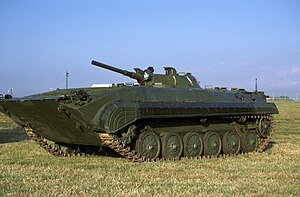BMP development
Included in the series are the mainline BMPs, the airborne variant BMDs, and licensed modified (i.e. MLI-84) and reverse engineered versions (i.e. Boragh, Type 86).
BMP stands for Boyevaya Mashina Pekhoty (Russian: Боевая Машина Пехоты), meaning "infantry fighting vehicle".
In the post-war era most armies started introducing fully tracked vehicles in the dedicated armored personnel carrier role, including the Soviet BTR-50, British FV432, and the US M113.
Further, while the APCs moved to and from combat the infantry section in the back had nothing to do, a claustrophobic environment where the men could not add to the fight.
The Soviets were the second to adapt to this new style of fully mechanized combat, issuing requirements and then introducing the BMP in mid-1960s, following after the more limited scale Western German Panzergrenadier deployment of the HS.30.
The armament had to provide direct support for dismounted infantry in the attack and defense and to be able to destroy comparable light armored vehicles such as the American M59 APC or the West German HS.30 IFV.
The original specification called for the vehicle to be armed with a 23 millimetres (0.91 in) autocannon,[2] however an innovative combination of the 73 mm 2A28 Grom low pressure smoothbore semi-automatic gun firing rocket-assisted projectiles and the newly developed 9S428 anti tank wire guided missile (ATGM) launcher for the selected 9M14 "Malyutka" (AT-3A Sagger A) ATGMs was used instead.
The smoothbore gun and the ATGM launching system were to be mounted in a compact one-man turret from the Tula Instrument Engineering Design Bureau (KBP).
The prototypes (designated as "objects" according to Soviet classification) were: During this time, the United States had successfully introduced the M113 armored personnel carrier in the Vietnam War in 1962.
Though not designed as a combat vehicle, its light armor and mobility was effective against most small arms employed by the Viet Cong forces.
The tracked Ob'yekt 764 was chosen, after a few improvements, because its front engine design provided a convenient and fast way of mounting and dismounting through two rear doors.
The BMP proved vulnerable to .50 caliber machinegun fire in the sides and rear, and to infantry-based 106 mm recoilless rifles.
Its low ground pressure enabled it to navigate the northern Kantara salt marshes where other vehicles would have bogged down.
A development program to completely address the shortcomings of the BMP was started at the same time resulting in four prototypes, all of which had two-man turrets.
688 weapons configuration—an externally mounted 30 mm gun and twin Konkurs ATGM launcher—was rejected; instead the new 2K23 armament system was selected.




